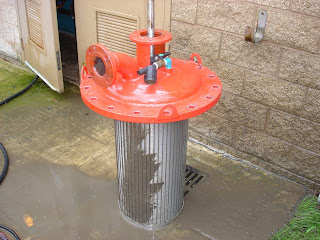Nor Cal PGA Junior Tour
 It's very humbling to see a 10-year-old girl hit the ball as far as I do while swinging half as hard. I saw displays like this for two days straight when the PGA Junior Tour kicked off the season with a stop in Stockton.
It's very humbling to see a 10-year-old girl hit the ball as far as I do while swinging half as hard. I saw displays like this for two days straight when the PGA Junior Tour kicked off the season with a stop in Stockton. The younger kids, some under the age of seven, were a real treat to watch. They really looked like tiny professional golfers with their mannerisms and golf apparel. They would step off distances, check the contours of the green from all angles, and most importantly, fix their ball marks.
The event was very well received by the membership at Stockton GCC. I believe it would be rare for a private club to give up the course to a bunch of kids on a beautiful spring weekend. Not only did they forgo their personal weekend tee-times, they also volunteered their time by marshaling, checking in guests, and helping to score the event.

The putting green surround served its last tour of duty this weekend and was ripped out early the next morning. As you can see in the photo above, common bermuda has contaminated the turf and was spreading towards the green.
The new sod spruced up this area instantly and should hold up for a couple of years before foot traffic takes its toll. Laying sod is an art form and doing it correctly will save a lot of time hand watering and repairing bad spots. The crew is good about monitoring each others work and pointing out mistakes in a teasing sort of way. Every one of them is getting very good at laying sod, but nobody is begging me to buy any more.

Disease Profile: Waitea Patch

I let the Waitea run wild for over a week until the repair date was backed up waiting for parts. We cleaned the tank on the 1992 model very thoroughly and went out yesterday to fix the problem. There is little to worry about with this phenomenal weather and a ugly, but weak disease.
I love closed Mondays
We are also testing out all of our aerifiers to get ready for the next month. The Wiedenmann will be punching the driving range tee, plugs will be broken up by a steel drag mat, and then we will hit it with some fertilizer to jump start the sleepy bermuda.
I have some many updates to post, but so little time to do so. Even now, as I'm writing this, I know my time is better served with a shovel in hand helping the staff around the putting green. Hopefully, I can sit down tonight and make up for lost time reporting some of our recent work and course events.
Here are some of the posts you'll be seeing in the near future:
- The inaugural event of the Northern California PGA Junior Tour hosted the last two days at Stockton Golf and Country Club
- Main line repair on #17
- Brown ring patch (Waitea) on most of our greens with the sprayer out-of-order
- Restroom remodeling in the maintenance shop (sounds exciting doesn't it?)
- Update on Izzo including a vicious dog attack right in my office
So stay tuned for more Stockton Turf News, and grab your clubs and hit the course because spring is officially here!!!
Happy St. Patty's Day
 No, these are not the new safety glasses for our employees. I bought these babies at Big Lots for $1.00 and I'm very satisfied with my purchase. Mario looks better in them than I do, so he volunteered to show them off.
No, these are not the new safety glasses for our employees. I bought these babies at Big Lots for $1.00 and I'm very satisfied with my purchase. Mario looks better in them than I do, so he volunteered to show them off.I have to spend most of the afternoon and part of the evening spraying fairways, but I look forward to pint of Guinness and some corned beef later tonight.
Have a safe and happy Irish Day!!!
Home Lawns: Crabgrass Control
I normally disregard the degree day model, going more on history and current weather patterns. I have applied pre-emergent as late as April 15th in some years, but this time around I'll be going a month earlier. Our long summers result in a long germination window for crabgrass so two applications may be necessary. Read the label of the product you are using and follow the instructions closely.
Finally, be careful not to over-fertilize your lawn during the 'Spring Green Up' promotion at your local garden supplier. Two-thirds of the nitrogen applied to your lawn should be put out during the fall months. That is the time of year when the plant builds up its roots. Spring comes with a growth flush that is mostly top growth. The reserves are being used to push the plant up and most of the nitrogen will do the same.Crabgrass is very difficult to remove from your lawn, so prevention is the key.
Lowe's and Home Depot benefit from 'Spring Green Up' much more than your lawn. A little fertilizer this time of year will go a long way.
Morning workout
 The other day, we outfitted one of our staff members with a pedometer to measure the distance travelled when walk mowing greens. Mario tried this out the first day and came back with 16,427 steps. We measured the distance of 25 paces and divided out to get 7.9 miles.
The other day, we outfitted one of our staff members with a pedometer to measure the distance travelled when walk mowing greens. Mario tried this out the first day and came back with 16,427 steps. We measured the distance of 25 paces and divided out to get 7.9 miles. Master Po, I hear the grasshopper

Mario Estrada is on the unit blowing rough along the fairway of number 16. Monday, we had three people mowing rough, two people on blowers, and two more dragging fences and mats to break up this mess. By the looks of the photo below, we got to this section of rough just in time.

Old man, how is it that you hear these things? ---------- Young man, how is it that you do not?
Squish, squish, squish
 That's what it sounds like when you talk a walk on the course after all of the recent rain. Now that temperatures are climbing, the grass is out of control and the clippings have piled up. We mowed as much rough as we could before the latest rain storms and the clippings matted down like cow patties. We have no choice but to hand rake all of these areas before the clumps of clippings kill the turf beneath.
That's what it sounds like when you talk a walk on the course after all of the recent rain. Now that temperatures are climbing, the grass is out of control and the clippings have piled up. We mowed as much rough as we could before the latest rain storms and the clippings matted down like cow patties. We have no choice but to hand rake all of these areas before the clumps of clippings kill the turf beneath. Preventative Maintenance

We are blessed to have a modern irrigation system and a pump house that is the best I've seen out of the seven courses I've worked for. Both of these components were installed in 2002 and are holding up very well. However, that is no reason to ignore annual maintenance of the system and wait for a problem before taking a look.
I pulled the following definition from Wikipedia and I think it describes the phrase very well.
Preventive maintenance (PM) has the following meanings:
1.The care and servicing by personnel for the purpose of maintaining equipment and facilities in satisfactory operating condition by providing for systematic inspection, detection, and correction of incipient failures either before they occur or before they develop into major defects.

Yesterday, Commercial Pump came out to the course to inspect and service our pump system and for the second visit in a row, they found a potentially massive problem. The hydraulic tube that senses pressure in the system was partially blocked and could mislead the computer to run the pumps until something ruptured or burned up. In addition, the computer system is water-cooled and that tubing was also partially blocked.
The pictures to the left show the removed filter that keeps most dirt and debris from entering the irrigation lines. The top photo is a good look at the brushes that periodically scrape the walls to remove buildup. The next pic shows
 the outside which is thoroughly washed before inspection. Finally, the last photo was taken inside the pump house. Here you can see the housing for the removed filter and the four pumps in the background.
the outside which is thoroughly washed before inspection. Finally, the last photo was taken inside the pump house. Here you can see the housing for the removed filter and the four pumps in the background. We came through this checkup with a clean bill of health and a couple of problems resolved before disaster struck. Once the gentlemen from Commercial Pump finished putting the system back together, we needed to fire on many sprinkler heads to test everything. This is always tricky because I don't want to soak all of the golfers on the course. This time I had a different problem and that was explaining why I was irrigating during a storm that dumped over a half-inch of water on the already saturated turf.




